A large part of being a successful soccer team comes down to how well the team communicates with one another. A team that communicates well will be organized and disciplined while defending, make better decisions on the ball, and create more attacking chances. Use these soccer drills to improve communication in your soccer teams.
In this post we will go over why communication in soccer is so important, different words and phrases you can use to help promote communication, and a variety of soccer drills you can use to improve communication.
This post goes into more depth about how football players communicate with each other.
Soccer drills that can help improve communication
These are my favorite soccer drills I use to help improve communication on my youth soccer teams. Each of the drills will include a brief explanation of the drill, how it helps improve communication and videos of how the drills work.
With each of these drills, you want to encourage players to give information when they play a pass. This will help the player receiving the ball make better decisions.
3v3 same field soccer drill to improve communication
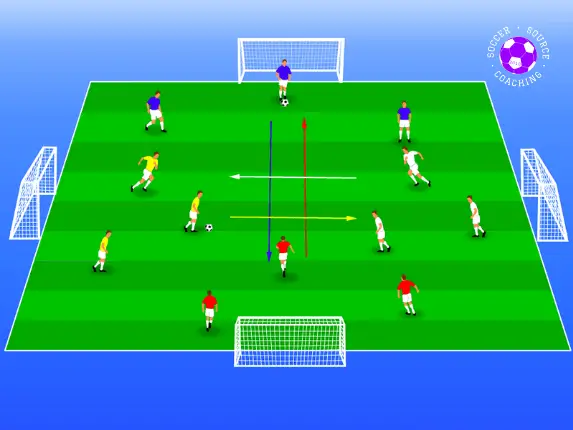
Set up:
- 15 x 15-yard area
- 4 goals
- 2 soccer balls
- 4 teams divided into groups of 3
How the soccer drill works:
After you have set up your area and divided up your players into teams place goals opposite each other vertically and horizontally.
This will create 2 games on one soccer field, with 2 teams playing in the goals vertically and the other 2 teams playing in the goals horizontally.
You can play games in 5-minute intervals and allow all teams to play each other.
Instead of throw-ins and corners, a kick-in will take place where ever the ball went out of play.
How the drill improves communication:
With this soccer drill there are a lot of moving pieces, not only do players have to be aware of their teammates and the opposition but also the other 2 teams in the area.
This will add a layer of chaos to the game where effective communication can greatly benefit the players.
What words and phrases you should encourage players to use:
- Man on
- Time
- Turn
- Switch
- Playback
Click here for more 3v3 small-sided soccer game ideas
3 teams keep ball communication soccer drill
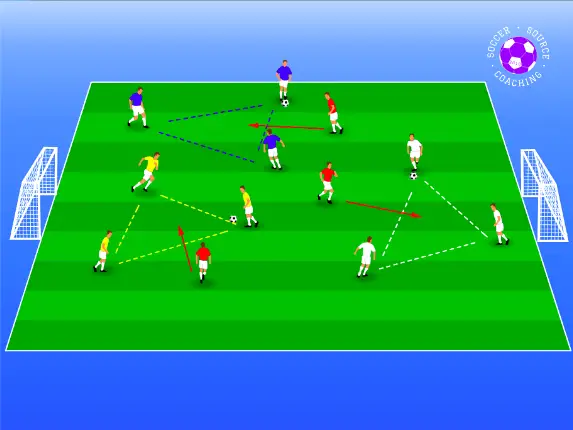
Set up:
- 15 x 20-yard area
- 2 goals
- 4 teams divided into groups of 3
- 3 soccer balls
How the soccer drill works:
This is a fun possession-based game that gives a lot of opportunities for players to communicate with each other.
Set up your field with 2 goals opposite each other on the 15-yard lines. With your 4 teams select one team to be the defenders and the other 4 teams will be the possessing teams.
The defending team must try and steal the ball of the possessing team and score either of the 2 goals.
The possessing teams must keep the ball away from the attacking teams to prevent them from scoring.
Each team will have a turn being the attackers and scoring as many goals as possible.
The team that scores the most goals as the defending team will be the winning team.
How the drill improves communication:
Similar to the previous soccer drill, there is a lot of chaos going on that players have to be aware of.
This environment should encourage the players to communicate with each other and help their teammates know what is going on around them.
What words and phrases you should encourage players to use:
- Man on
- Time
- Turn
- Playback
- 1, 2
1v1 soccer drill with 2 magic players
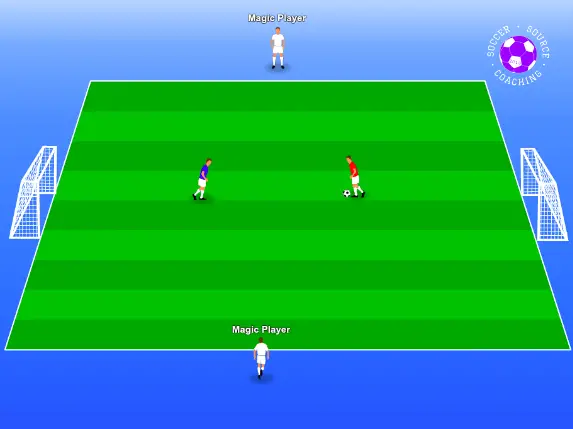
Set up:
- 10 x 15-yard area
- 1 soccer ball
- 2 goals
- 4 players
How the soccer drill works:
Set up your area with 2 goals opposite each other on the 10-yard lines with 1 bounce player on each 15-yard line.
The drill will be a regular 1v1 in the middle however players in possession of the ball may use the bounce players on the side to combine passes.
This will give players different routes to explore success while in a 1v1 scenario.
How the drill improves communication:
For the middle players to gain success from this and score goals it requires all 3 players (1 middle player in possession of the ball and 2 bounce players) to be on the same wavelength.
Due to the setup and area size, it does not give the middle players much space or time to work with.
This is why being able to effectively communicate with the bounce players on the outside will help speed up decisions on and off the ball.
What words and phrases you should encourage players to use:
- Man on
- Time
- Turn
- Playback
- 1,2
- Switch
As well as using verbal communication to encourage players to point where they would like the ball to help speed up the decision-making of the players.
Click here for more 1v1 dribbling soccer drills
2 goal soccer communication game
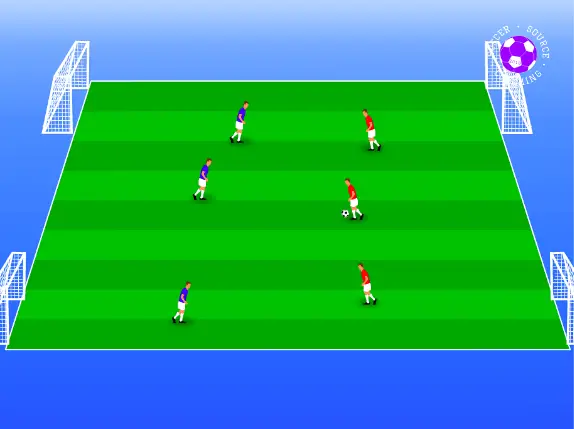
Set up:
- 15 x 20-yard area
- 4 goals
- 1 soccer ball
How the soccer drill works:
Create your area and instead of placing 2 goals opposite each other place 4 goals opposite each other in each of the corners.
The teams will now have to defend their 2 goals or score the opponent’s 2 goals.
Instead of corners, there will be kick-ins from in the middle of the two goals. If the ball goes out on the sides then you can either play from kick-ins or throw-ins.
How the drill improves communication:
The main purpose of this drill is to help teams collectively realize where there is space to exploit on the soccer field. By encouraging your players to communicate they can effectively work together to move the ball to space to attack.
The more effective the communication the quicker the off-ball and on-ball decisions can be made, which means teams will attack quicker and with more purpose.
What words and phrases you should encourage players to use:
- Turn
- Switch
- Playback
Click here for more spacing soccer drills
2v2 defending soccer communication drill

Set up:
- 10 x 15-yard area
- 3 goals
- 1 soccer ball per 4 players
How the soccer drill works:
Create your area and divide your players into defenders and attackers.
Each phase will consist of 2 defenders and 2 attackers playing at the same time. The defenders will be defending 1 goal with the attackers defending the other 2 placed in their respective corners.
The defenders will start with the ball and the drill will begin once a defender players the ball to the attacker.
The attacker must try and score in the one goal with the defender trying to win the ball back and score in either of the attackers’ 2 goals.
If the defenders can score in the attackers’ goal they will get 3 goals instead of 1
How the drill improves communication:
This is a defensive drill that works on how players can defend in pairs. To prevent the attackers from scoring the defenders must work together.
By talking to each other the defenders will have a better understanding of when to press and who should try to win the ball back.
If one player is pressing then the other player should be covering the space behind.
If the defenders gain possession of the ball communicating will help them attack and retain possession a lot more effectively.
What words and phrases you should encourage players to use:
- Press the ball
- Cover
- Turn
- Playback
- Time
Waves attacking/ defending communication soccer game
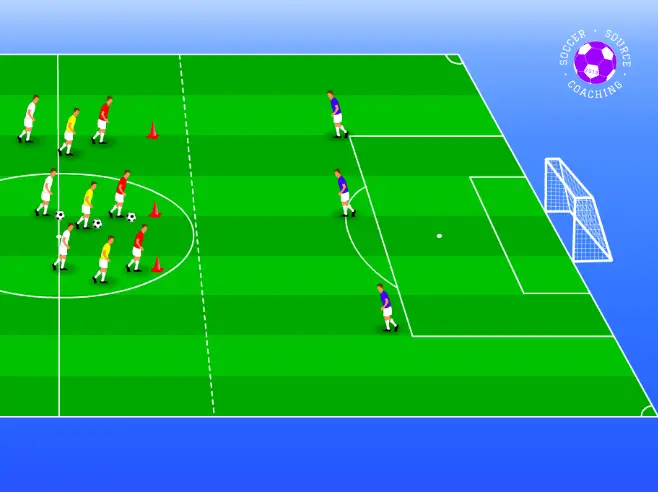
Set up:
- 15 – 20 yard area
- 1 goal
- 4 teams of 3
- 1 soccer ball per team
How the soccer drill works:
Set up your area with the goal on a 15-yard line and divide your players into 4 equal teams of 3.
The players’ teams will start at the opposite 15-yard line each with a ball.
The first team will combine passes and take a shot on goal.
As soon as the shot is taken they will become defenders, with the next team starting to attack.
The next team will attack when the ball has gone out of bounds, a goal has been scored or the defending team can dribble past the line that the attacking team starts on.
If a team scores a goal they will get 3 points and if they can steal the ball and dribble past the line they will get 1 point.
How the drill improves communication:
This will help players communicate because of the quick transition from attack to defense. For a team to succeed in this soccer drill they must communicate well to stay organized when attacking or defending.
What words and phrases you should encourage players to use:
- Press the ball
- Cover
- Switch
- Turn
- Playback
- Time
Why communication in soccer is important
Communication on the soccer field will either come in the form of verbal or nonverbal communication.
Verbal communication is where you would use words or phrases to help give information to a teammate compared to non-verbal communication where you would use your body language, eye contact, or hand signals to give messages to your team-mate.
When you combine both of these methods of communication teams can provide more information to the players on the soccer field, which will help them make quicker and better decisions either on or off the ball.
Teams that communicate with each other consistently will have a heightened sense of their teammates’ movements on and off the ball and look fluid when attacking or defending.
Communication also helps builds a layer of trust between players as you are relying on teammates to give you information to help you succeed on the field.
This is why as a coach you must make a conscious effort to support player-to-player interactions as much as possible
words, phrases, and signs that can improve communication in soccer
In soccer decisions need to make in a split second, this can be the difference between scoring a goal or giving the ball away in a dangerous position.
This is why the way players communicate needs to be short, concise, and to the point.
The language that is used must always be consistent too.
In soccer there a different words and phrases that all mean the same thing, this can add a layer of confusion to a situation and slow down the decision-making as players will have to think harder to process what has been said.
If you are interested I have a post on what language soccer players speak.
Words and phrases to introduce to your players
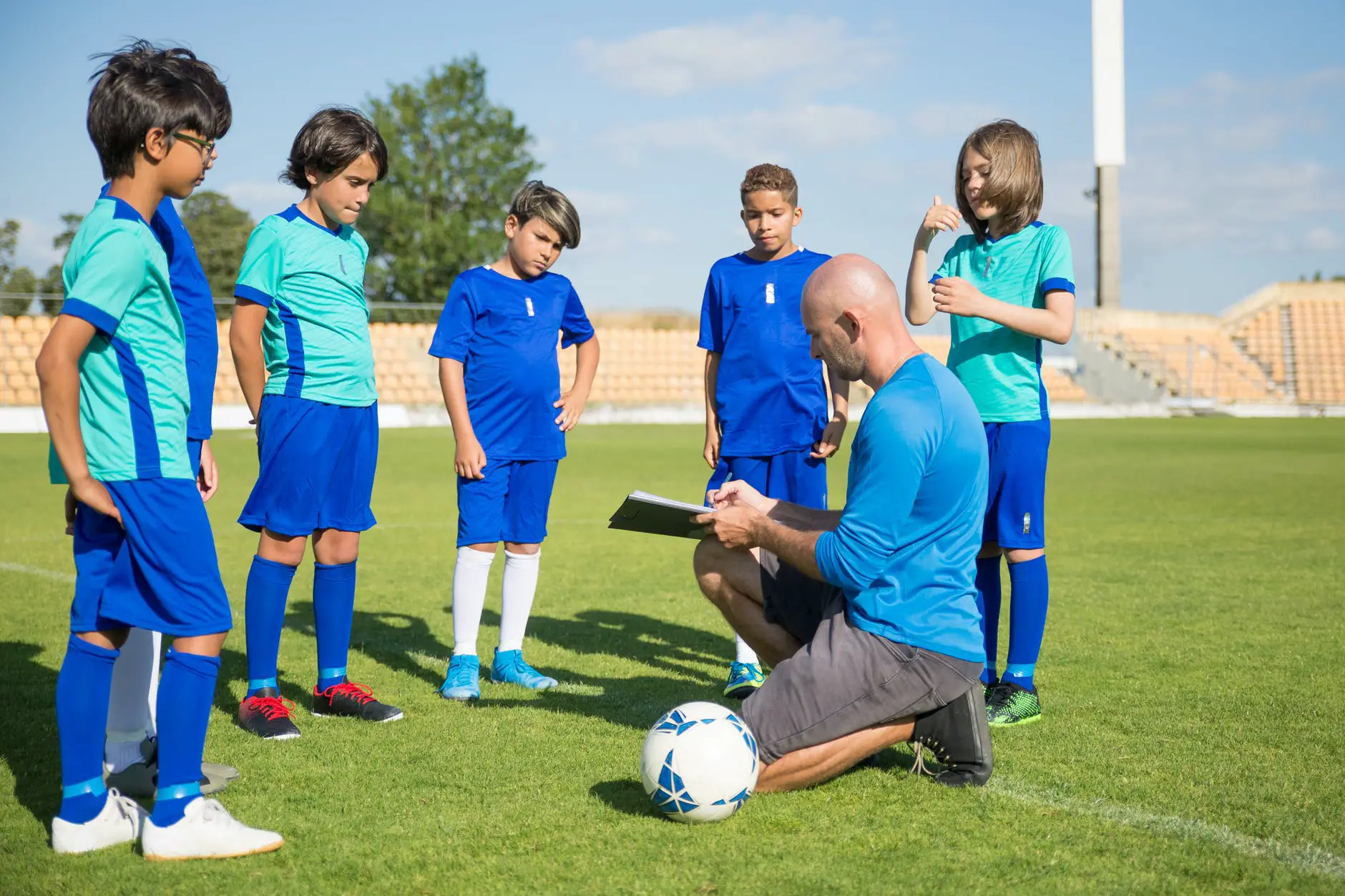
- Man on
This is used when the player on the ball has an opposition closing them down from an angle in their blind spot. To help be more precise you can let the player know which direction the player is coming from.
For example ‘man on left’ will make the player on the ball aware that a player is pressuring from the left.
- Time
Shout time when your teammate receives the ball to make them aware that they relax on the ball and gain some composure.
- Turn
This word is used to inform players receiving the ball that they can turn into their blindspot as there is space for them to do so.
For example, if a central defender passes the ball to the central midfielder who facing their own goal but shouting ‘turn’ the central midfielder knows they can turn with the ball so they are now facing the opponent’s goal.
You can also give more information to the player by letting them know whether to turn right or left.
- 1, 2
This is used to describe a combination pass between 2 players.
If the player on the ball shouts ‘1,2’ the player receiving the ball knows that the player will be prepared to receive the ball back.
- Switch
This word is used to make the player on the ball aware that there is space on the other side field and a player waiting to receive the ball.
- Playback
When players let their teammates know to playback it means that they are an option to back to them if they cannot work a pass or a dribble forward.
- Step up
This phrase is used prominently in the defensive line when the ball has gone upfield and the defenders need to move toward the halfway line.
The reason for this is to prevent forwards from staying onside and reduce the amount of space for the opponents’ attackers to exploit.
- Press the ball
This is a phrase that can be used when your team is out of possession of the ball.
This can mean collectively as a group of players putting pressure on the ball to force the opponents in a certain direction or force them into a mistake.
Also, you can be more specific and add individuals’ names before the phrase so that they know they should be putting pressure on the player with the ball.
- Cover
This is used to make teammates aware that a player is covering the space behind them.
For example, if a player has carried the ball out from the back a player can shout ‘covering’ the player knows that a teammate is covering their position so they can continue their run to help support and attack.
Another example is when a team is defending as a group if a player shouts covering then you know if you press the ball you have someone covering behind you in case the attacker gets past.
Soccer drills to improve communication conclusion
Remember that communication is something that doesn’t happen overnight but it all has to start somewhere. For a team to successfully communicate the coach must consciously remind players to talk in drills, scrimmages, and games.
Another thing that can improve team communication and chemistry is the duration of time a group of players has been together.
The longer a group of players has been together the more trust and deeper understanding they have with one another.
If you found these soccer drills to improve communication helpful or know a coach that would find these soccer communication drills useful then please share them using our social media buttons.
Thank you,
Toby.
Want more drills? We have over 300+ soccer drills.
Related Posts:
- 10 Soccer Drills To Teach Spacing
- Soccer Drills for Passing and Moving
- 10 Possession Soccer Drills
My Soccer Coaching Equipment
If you opened my coaching bag this is the soccer equipment you’d find!
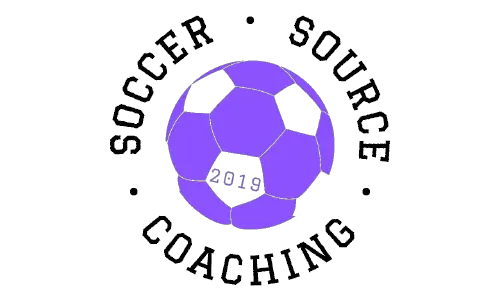
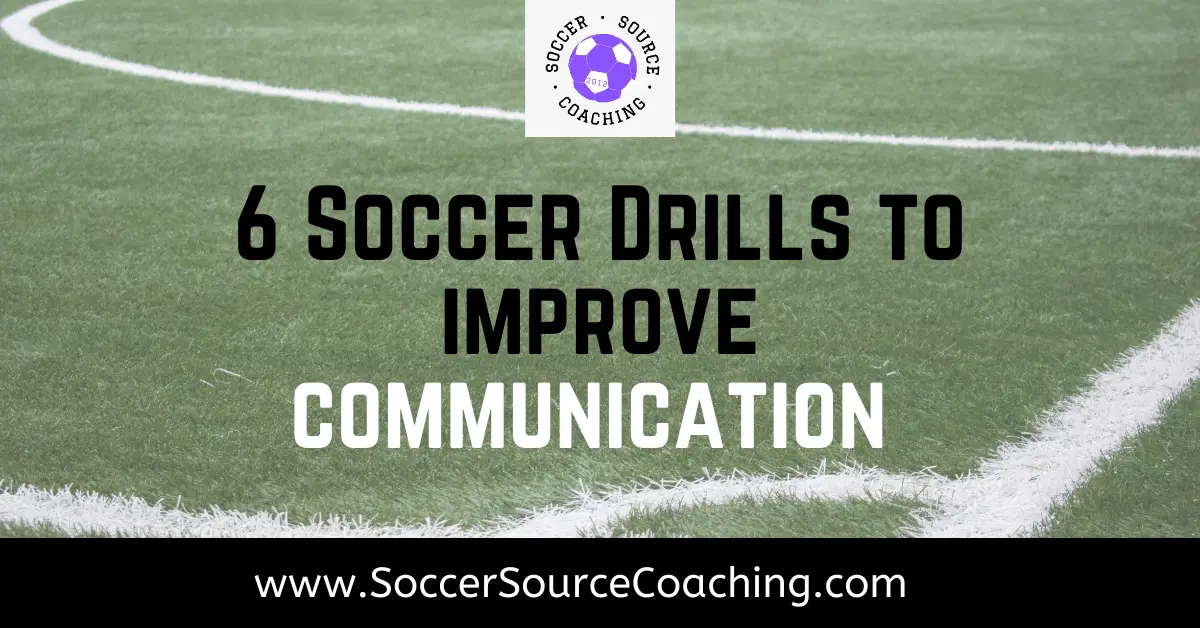
1 thought on “Soccer Drills To Improve Communication | 6 Amazing Drills”
Comments are closed.